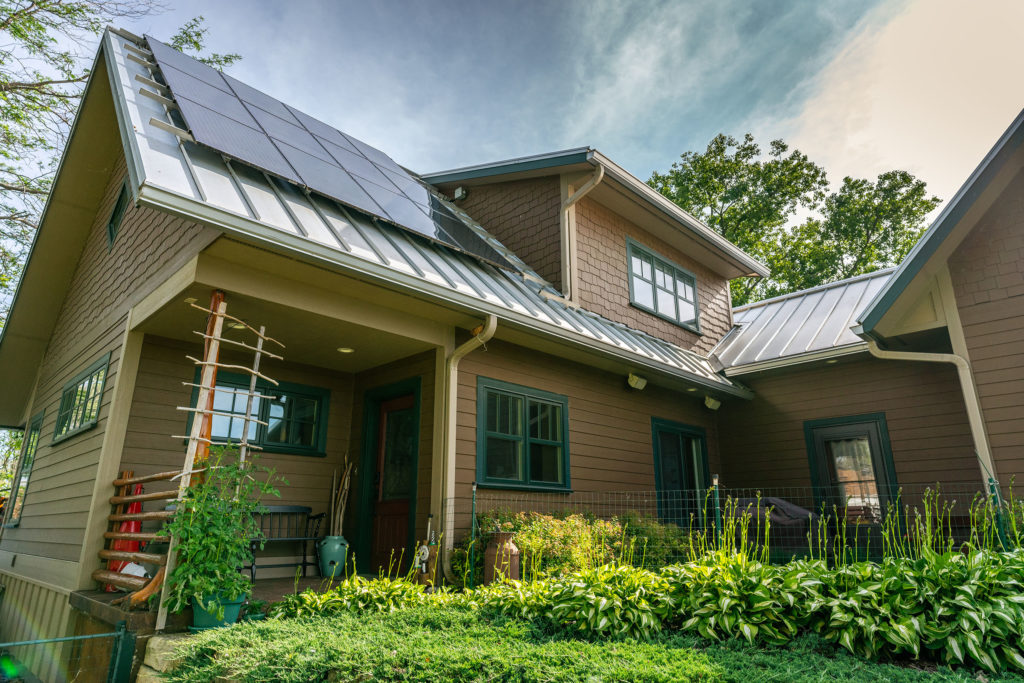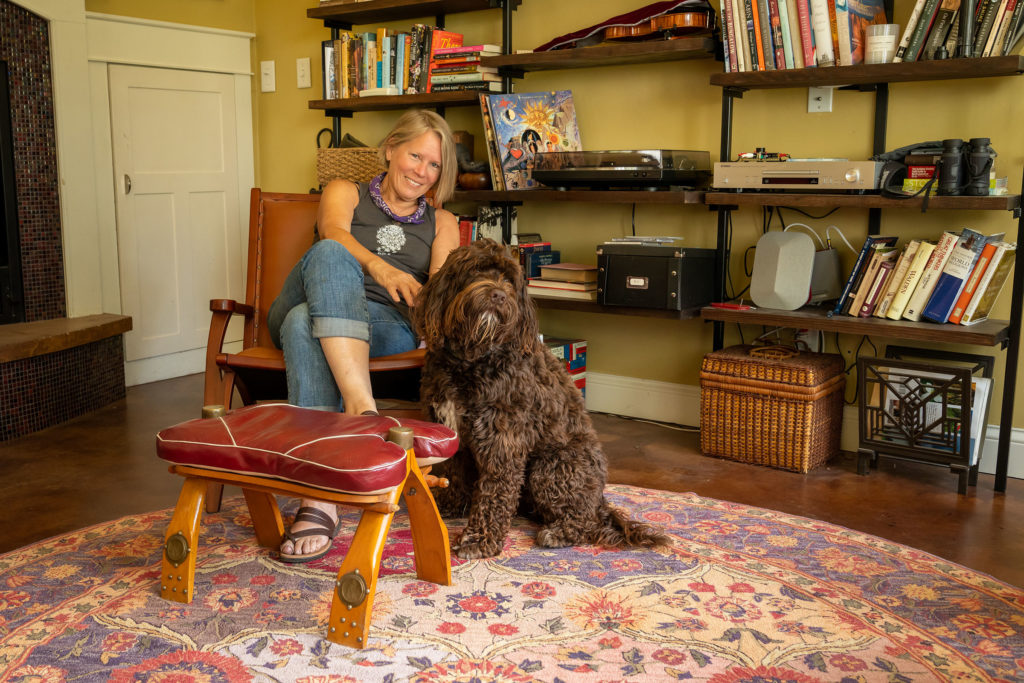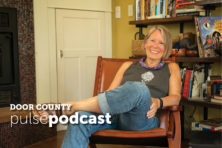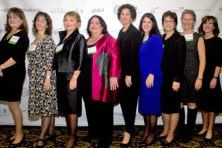The Pioneer: Architect Virge Temme
- Share
- Tweet
- Pin
- Share

High-performance home designer and architect Virge Temme has officially retired — but not from convincing people that the world can be changed one house at a time
When I pulled into the gravel drive leading to the home of architect Virge Temme, she was outside rummaging in the back of her Dodge Ram City Van. The white home before me was charming, with clean lines and a simple elegance recognizable even to the untrained eye.
Temme had designed the home located not far from the bay of Little Sturgeon, and together, she and husband Brett had torn down the original 1940s cottage to its foundation, and built their home back up in 2002. Architect Meghan Hawkins, who has been to the home, said that with the exception of its contemporary twist, it looked like it could have been built on the site 100 years ago.
“And it’s hard to get those historic things right,” said Hawkins, who, as founder of Evolve Design Workshop in Madison, designs homes across the state, including in Door County. “There are really particular things with proportion and the size of overhangs that are really easy to get wrong. And she did it with such skill.”
Temme’s American water spaniel, Emmett, bounded toward my car and hopped inside once I opened the door. Temme walked over, smiling. She has been honored with a sustainability award that has been given only to women such as Hillary Clinton, yet she appeared completely down to earth, her attire as casually stylish as her short, blonde hair: long-sleeved T-shirt, jeans, boots. She didn’t wear any makeup to define her blue eyes, high cheekbones or classic Czech jawline that even now, at 68 years old, wasn’t surrendering much to gravity.

This home is a rare example of one of Virge Temme’s larger designs. At 4,200 square feet, the home has tradeoffs that reduce its carbon footprint and enable it to be more environmentally sustainable and energy efficient. Photo by Brett Kosmider.
“Ready for some lunch?” she asked, after completing a tour through the voluptuous gardens surrounding the house, the chicken coop, the plans for future improvements. “I have water or wine.”
A pause. I was sitting on a stool at her kitchen island facing a sunken living room lined with windows that brought the outside in. The harmonious, refuge-like space and Temme’s warm personality made wine seem like the perfect choice. It was easy to see why she’s remained close, lifelong friends with many of her clients.
“Virge is about relationships — relationships with her clients, subs, suppliers, regulators and bankers,” said past client Steve Mumma.
But the occasion for the visit was an interview. Temme is retiring from 22 years of designing homes on this peninsula through Virge Temme Architecture. Some 200 homes in Door County carry the Temme imprimatur, either through a remodel or custom home.
Her retirement will be official when her final two homes are completed in December 2021.

The LEED Platinum-rated, net-zero, 2,240-square-foot home of David and Chris Kellem illustrates resilient design in a flood-prone area. Photo by Brett Kosmider.
She’s Got Grit
The homes Temme designs aren’t just pretty. A glance up at the solar panels splayed across her home’s roof reveals a greater purpose.
She’s spent the better part of her Door County career designing environmentally ambitious, high-performance homes that are tight, resilient and energy efficient. Her work is based on scientific design principles from the Passive House Institute U.S. (PHIUS) and Leadership in Energy and Environmental Design (LEED) that can put a home on the path of net zero or net zero ready: generating as much energy as the home consumes over the course of a year, with no use of fossil fuels.
For the bulk of her career, Temme has been the area’s sole designer and voice for sustainability and green building, putting the peninsula on the map for its concentration of high-performance homes.
“I don’t think there is any area in the state that has as many LEED or high-performance homes,” said Hawkins, a co-founder of the Passive House Alliance-Wisconsin, a state chapter of PHIUS. “It’s really incredible what she’s done, going off on her own and really making a name for sustainability and this kind of construction in Wisconsin.”
A high-performance home is one that’s tighter, quieter and more energy efficient because it has better windows, more insulation, maybe double-walled construction and concrete floors. It also means the home is more healthful for its occupants because consideration is given to all the materials that go into building it, from their manufacture, to their application, to the end of their life cycle. The homes are also a lot less expensive to heat and cool without sacrificing comfort.
“If you have a house that was built properly to start with, then you’re offsetting all those costs and saving more and more money as time goes on,” Temme said.
She learned about climate-specific housing design and sustainable landscaping while in graduate school as part of a team that designed a fully sustainable neighborhood in Fort Hood, Texas.
That experience formed the basis of her devotion to sustainable design, She learned by doing, her designs evolving with her concerns about the depletion of natural resources and a homeowner’s ability to withstand the ever-increasing energy costs of a climate-changed world. She backed those concerns with research, then blazed her trail through a landscape of large, code-built homes that prioritize bottom lines and profit margins over environmental responsibility.
“Everything I profess states that we should build no larger than needed to consume fewer natural resources, make what you build as environmentally sound as possible, and concern yourself not just with the bottom line, but with the life-cycle cost and overall human benefits of high-performing building,” she said.
If Temme’s unapologetic criticism of mainstream house building has not endeared her to the traditional home-building community, she’s captured the hearts and minds of architects, subcontractors, clients and designers who are following the same path.
“She’s got grit,” said Christi Weber, director of design and LEED designer at TDS Custom Construction, a Madison-based firm that designs and builds net-zero and passive homes. “As a woman, growing her career at the time she did was definitely difficult. It’s difficult for women in this industry in general, and she didn’t always have the best treatment. There are many women who have paved the way and made it easier for us, and I really appreciate someone like her who didn’t let it get her down or make her do anything less than she believes. I truly consider her one of the pioneers.”
A Circuitous Path
Temme was a 31-year-old, divorced, single mother of a young son when she finally learned that architecture was her calling.
“When the universe wants you to head in a certain direction and you don’t, it gives you a swift kick,” Temme said.
Virgil Tibbs was a general contractor who owned his own company, Tibbs Construction, in Pontiac, Illinois, a city about 100 miles southwest of Chicago. Virgean Tibbs, the youngest of three daughters, was his namesake and the son he never had. She shortened the name to Virge to avoid her teachers’ embarrassing pronunciations and made it legal when she married Brett almost 30 years ago.
Temme grew up in a sawdust pile by her father’s side. She recalled being in his workshop drawing small houses to his big ones, and clambering down off the stool beside him to pilfer wood for the forts she built in the neighborhood cornfields. Her father died of emphysema when she was 11 years old. She remembers him as a quiet, ethical, philosophical man who believed that everyone deserved a good home.
“He ended up building most of the homes in our neighborhood — the post-World War II, 600- to 800-square-foot homes like the ones on 6th Avenue in Sturgeon Bay,” she said.
Time at Illinois State earned Temme more than enough credits to graduate, but not in any one thing. Instead, a cross-country hitchhiking adventure came next, followed by marriage and the birth of her son, Jake. Along the way, she refinished an attic or constructed a lean-to or reconfigured space wherever she was living. Her husband at the time, tired of being a father, abandoned his wife and young son, forcing Temme into the role of sole provider.
“And I had no marketable skills,” she said.
She took a secretarial class and landed a job as the assistant to the plant manager of a candy company. In a twist of fate that would seal her own, the company was undergoing a remodeling project, and Temme became the liaison between the plant manager and the architect and interior designer.

The 1,418-square-foot home, completed in 2020, illustrates spatial economy and passive solar design details. It’s all electric, with energy-conserving appliances and LED lighting, and it’s considered net zero ready. Photo by Brett Kosmider.
The architect noticed Temme could easily read plans and visualize in 3-D; the interior designer saw that Temme talked about long and short views and opening up walls, rather than wall coverings and window treatments. They both told her she should be an architect.
Their advice gave her the clarity she’d lacked at Illinois State. Yet now, as a single mom, she had no flexibility or money for tuition to finish her undergraduate degree. Instead, she called her shop teacher from high school to ask whether he knew anyone who could give her drafting lessons. He said he’d do it.
“He said, ‘It’s about goddamned time,’” Temme recalled. “‘You should have done this right out of high school.’”
Later, a residential construction firm posted an ad for a designer. Temme worked 72 hours straight on her first home design — a cute, little bungalow, she recalled — to meet the application deadline, then put on her best dress and applied.
“I landed the job as the head designer,” she said.
She returned to school and then continued to get her master’s degree in architecture from the University of Illinois-Champaign, meeting her husband, Brett, while he was there finishing his degree in aeronautical engineering.
Brett has been the primary person with whom she kicks around questions and thoughts regarding her business practices and design issues. His job with a nautical engineering firm in Sturgeon Bay brought them here in the summer of 1997 after having visited only once for a weekend.
“It’s almost like Door County calls the people it wants, and when Door County calls you, all the obstacles just disappear,” Temme said. “We have deeper roots here than I’ve ever had anywhere.”
She founded her company a little more than a year after landing in Door County. Her first memorable project was a remodel addition for a farmhouse in 1999 for Bob and Karen DeNoto. Within six months of that, she designed her first sustainable home. She’s never looked back.
A Vision for the Future
Temme’s energy seems the same as that of her husband, who’s 10 years younger. Her clients and peers describe her using words such as “tireless force” and “perseverance,” and as someone who’s still making positive changes to the world of design and architecture.
“She’s got a lot of light and power in her that never seems to go out,” Weber said.
Temme acknowledged that she’s leaving at a high point: proud of what she’s done and knowing she’s helped to change the mindsets of a large swath of the community.
“Virge was intent on educating others — both us as her clients, as well as all the craftspeople she brought to the project,” said Karen Dickmann about the Jacksonport home Temme designed for her and her husband, Jeff. “She would push back on any ideas we had that were not efficient, and she would do so by questioning why and offering other solutions.”

Virge Temme (above, with her American water spaniel, Emmett) was recognized by gb&d (Green Building and Design) magazine and the U.S. Green Building Council with a Women in Sustainability Leadership Award in 2017. Photo by Brett Kosmider.
But retirement for Temme means channeling her energy and creativity away from design work and toward research and writing for the cause of sustainable building. With millions of new homes constructed every year, there’s too much at stake to give up that fight.
“The impact of that massive amount of construction obviously has a profound impact on the environment of our future,” she said. “[In] my next phase of my life, I want to really be able to dive into more research on this.”
And Temme is well positioned to make an impact. Gov. Tony Evers appointed her to the Uniform Dwelling Code Council in December 2020 for her knowledge of energy-efficient design. That council has been charged with reforming building codes in the state that haven’t changed since they were developed in the 1970s.
“His and my hope is that I can help guide the state to higher energy standards than current code requires,” Temme said.
She’ll come at this problem not just as an architect, but also as the general contractor she became five years ago. Her sister company, SAGE Homes, oversaw the construction of her own designs.
“I understand pricing and the obstacles they’re facing,” she said. “I feel I have feet in both worlds and hopefully can help builders understand it’s not as big a wall as they think it is.”
That also means educating the banking, insurance and appraisal industries about the costs and values of passive building. It’s more expensive to build a high-performance home — the exact cost difference is being developed by the Passive House Alliance-Wisconsin — but with escalating energy prices and increased durability, the long-term expenses that are saved recoup the higher upfront costs.
“Spend more upfront, and you spend less out of pocket every month to live in your house,” Temme said.
Retirement will mean carving out time to do what she said she’s neglected during a busy, demanding career: spending time with family and friends, doing a home-renovation project, caring for her stunning gardens and practicing the violin her husband bought her two years ago. Woven throughout that life, she’ll also continue doing the same thing, but in a different way: changing the world one house at a time.
“I’m hoping in time it’s not going to be a Virge Temme thing; it’s not going to be a sustainable thing; it’s not going to be a high-performance thing,” she said. “It’s just going to be, ‘This is how we do it.’ That is my ultimate goal. That is what I hope is going to happen.”
Passive Home, LEED & Net Zero
Architect Virge Temme has been trained and certified in passive homes, and she uses the LEED certification system to rate the performance of the homes she’s designed. For the past decade, she has taken on only those clients who want net-zero or net-zero-ready designs.
Passive homes and net-zero homes both aim to reduce energy consumption and carbon emissions through greater efficiency. Passive building achieves this by allowing little energy to escape from the home. Net-zero homes achieve it by ensuring that the home generates enough power to balance its energy consumption.
The nonprofit
Passive House Institute US (PHIUS) is committed to making high-performance passive building the mainstream market standard, in part through training and certifying professionals. Buildings that meet the PHIUS+ standard use 40% to 60% less energy for space conditioning than conventional buildings.
The U.S. Green Building Council’s LEED program – Leadership in Energy and Environmental Design – is the most widely used green-building rating system in the world. LEED provides a framework for healthy, highly efficient and cost-saving green buildings.



